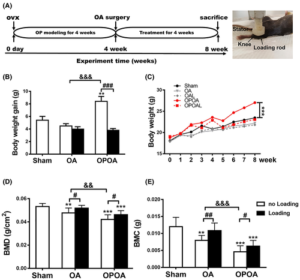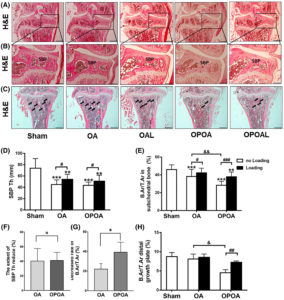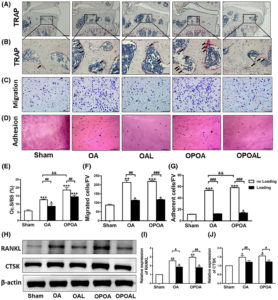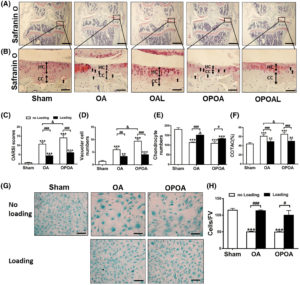Any loading study with pictures can provide insight on the possibility of ectopic chondrogenesis/endochondral ossification even if they do not directly study longitudinal bone growth as long as there are images.
One method to grow taller as adult:
1)Induce bone degradation allowing space for new growth plates to form(one way this could be induced is by inducing fluid flow flow in the bone via joint loading)
2) stimulate new growth plate formation via mesenchymal condensation(this would be induced by hyrostatic pressure via joint loading)
3) induce endochondral ossification of the ectopic cartilage. This would happen naturally due to the bone microenvironment.
“Osteoporotic osteoarthritis (OPOA) is a common bone disease mostly in the elderly, but the relationship between Osteoporotic (OP) and osteoarthritis (OA) is complex. It has been shown that knee loading can mitigate OA symptoms. However, its effects on OPOA remain unclear. In this study, we characterized pathological linkage of OP to OA, and evaluated the effect of knee loading on OPOA. We employed two mouse models (OA and OPOA), and conducted histology, cytology, and molecular analyses. In the OA and OPOA groups, articular cartilage was degenerated and Osteoarthritis Research Society International score was increased. Subchondral bone underwent abnormal remodeling, the differentiation of bone marrow mesenchymal stem cells (BMSCs) to osteoblasts and chondrocytes was reduced, and migration and adhesion of pre‐osteoclasts were enhanced. Compared to the OA group, the pathological changes of OA in the OPOA group were considerably aggravated. After knee loading, however, cartilage degradation was effectively prevented, and the abnormal remodeling of subchondral bone was significantly inhibited. The differentiation of BMSCs was also improved{this is the kind of thing we would be looking for}, and the expression of Wnt/β‐catenin was elevated. Collectively, this study demonstrates that osteoporosis aggravates OA symptoms. Knee loading restores OPOA by regulating subchondral bone remodeling, and may provide an effective method for repairing OPOA.”
“Since bone is a mechano‐sensitive organ, moderate pulsating loading, oscillatory compressive loads, can be applied to various synovial joints in a form of elbow loading, knee loading and ankle loading. Joint loading can change intramedullary pressure of bone cavities. The moderately changing pressure may generate fluid flow in a lacuna canalicular network in bone cortex, and activate anabolic genes in bone{the goal would that a change in hydrostatic pressure in the bone would stimulate ectopic chondrogenesis/endochondral ossification}. In our previous studies, we have shown that knee loading is effective in …promoting longitudinal bone growth…”
“Dynamic loads were sinusoidal at 1 N (peak‐to‐peak) and the frequency was 5 Hz for 6 min/day (each knee, 3 min).”
It’s here that we’d look for signs for ectopic chondrogenesis. It’s hard to tell for sure as there’s no loading group for normal bone. In the the loading groups(OAL, OPOAL) there are clear differences in the subchondral bone plate. Although the loading groups, all seem to have differences in the bone but the differences seem stronger in the trabecular bone. The growth plate is different in the loaded groups but that’s not going to make a difference to adults.
In this it looks like there may be more cellular condensation in the OAL group and the OPOAL group(there are more cells and they’re closer together). This is a precursor to mesenchymal chondrogenesis. We’d need signs of bone degradation as well to prove that growing taller as an adult is possible. And it’s hard to say that without seeing a normal bone.




